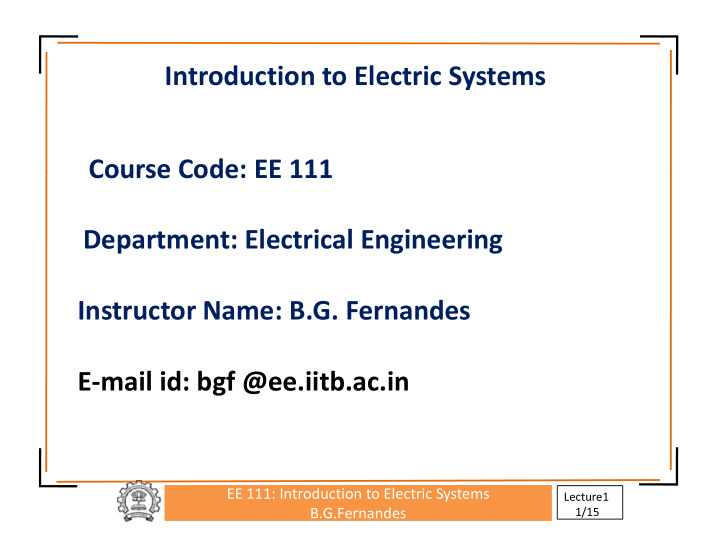



Introduction to Electric Systems Course Code: EE 111 Course Code: EE 111 Department: Electrical Engineering Department: Electrical Engineering Instructor Name: B G Fernandes Instructor Name: B.G. Fernandes E ‐ mail id: bgf @ee iitb ac in E ‐ mail id: bgf @ee.iitb.ac.in EE 111: Introduction to Electric Systems Lecture1 B.G.Fernandes 1/15
OVERVIEW 1. Passive Components, Signal Sources, KCL, KVL, l Network Theorems. 2. Time domain response of Simple RC, RL circuits. 3. Sinusoidal steady state analysis of electrical y y circuits, Frequency Response. 4. Balanced three phase circuits. 5. Mutually coupled circuits. 6. Magnetic Circuits. 7. Transformers. EE 111: Introduction to Electric Systems Lecture1 B.G.Fernandes 2/15
8 D C Machines 8. D.C. Machines. 9. Induction Machines. 10. Synchronous Machines. 11 Stepper motors 11. Stepper motors. 12. Ratings of generators, motors and transformers, motor applications motor applications. 13. Industrial power distribution, protection & safety & safety. EE 111: Introduction to Electric Systems Lecture1 B.G.Fernandes 3/15
Reference Books: A) Text reading i i. Vincent Del Toro, “Electrical Engineering Vi t D l T “El t i l E i i Fundamentals – Second Edition”, Prentice Hall 1989. ii. P. C. Sen, “Principles of Electrical Machines & Power Electronics”, John Wiley & Sons. i. Ralph J. Smith, “Circuits Devices & Systems”, John Wiley & Sons. iii. I.J. Nagrath, “Basic Electrical Engineering”, Tata McGraw Hill. EE 111: Introduction to Electric Systems Lecture1 B.G.Fernandes 4/15
B) General reading (for Sr. No. 1,12,13) ) g ( ) i. K Chen, “Industrial Power Distribution and Illuminating Systems”. ii. Donald Beeman, “Industrial Power Systems , y Hand book”. iii iii. Fink and Beaty, Electrical Engineering Fink and Beaty “Electrical Engineering Handbook” or any other author EE 111: Introduction to Electric Systems Lecture1 B.G.Fernandes 5/15
Marks Distribution(Tentative): First mid ‐ semester exam 30% End Semester exam 50% Quiz 10% H Home assignments + attendance 10% i d 10% EE 111: Introduction to Electric Systems Lecture1 B.G.Fernandes 6/15
Notes: 1. Home assignments will be normally distributed on Friday and are required to be submitted on Wednesday. The difficulties in the assignments could be discussed with the instructor. 2. There will be 3 quizzes and the dates will be announced in class (There may be surprise quizzes). There will be no make ‐ up for the quizzes. EE 111: Introduction to Electric Systems Lecture1 B.G.Fernandes 7/15
“ “It is essential that a student acquire an understanding l h d d d of and a lively felling of values. He must acquire a vivid sense of the beautiful and morally good Otherwise he sense of the beautiful and morally good. Otherwise he with his specialized knowledge more resembles a well trained …. than a harmoniously developed person .” y p p Albert Einstein Albert Einstein EE 111: Introduction to Electric Systems Lecture1 B.G.Fernandes 8/15
Motivation : • Mobile Charger ⇒ I ⇒ Input is A.C & output is LOW VOLTAGE D.C t i A C & t t i LOW VOLTAGE D C EE 111: Introduction to Electric Systems Lecture1 B.G.Fernandes 9/15
⇒ • Power Generation Remote Places ⇒ Consumption Urban areas EE 111: Introduction to Electric Systems Lecture1 B.G.Fernandes 10/15
Power Scenario in India: • Installed Capacity: 1,40,000 MW • Peak power deficit: 17% • Generation: G i ⇒ Thermal 63% ⇒ Hydro 25% ⇒ Renewable 7.7% R bl 7 7% ⇒ Nuclear 2.9% EE 111: Introduction to Electric Systems Lecture1 B.G.Fernandes 11/15
Thermal power plants in India Courtesy: Mapsofindia.com EE 111: Introduction to Electric Systems Lecture1 B.G.Fernandes 12/15
Hydro power plants in India Courtesy: Mapsofindia.com EE 111: Introduction to Electric Systems Lecture1 B.G.Fernandes 13/15
Nuclear Power plants in India Courtesy: International Nuclear safety center EE 111: Introduction to Electric Systems Lecture1 B.G.Fernandes 14/15
• Generators at Mumbai & at North East run b h same speed !. • Generators at Mumbai & at Karwar(Karnataka) may not run at same speed • Which generator to be used for power generation from wind? • For low power applications ‐ Robotics, printers – rotation is in discrete steps p EE 111: Introduction to Electric Systems Lecture1 B.G.Fernandes 15/15
Recommend
More recommend